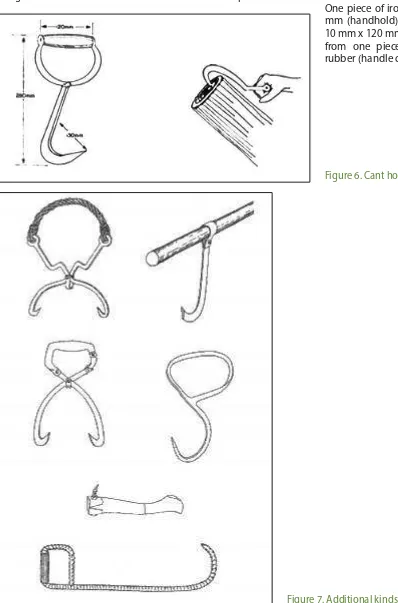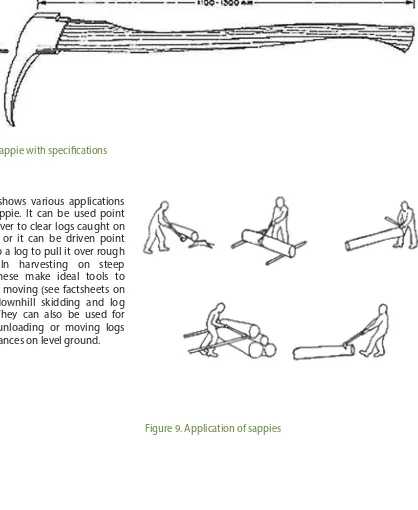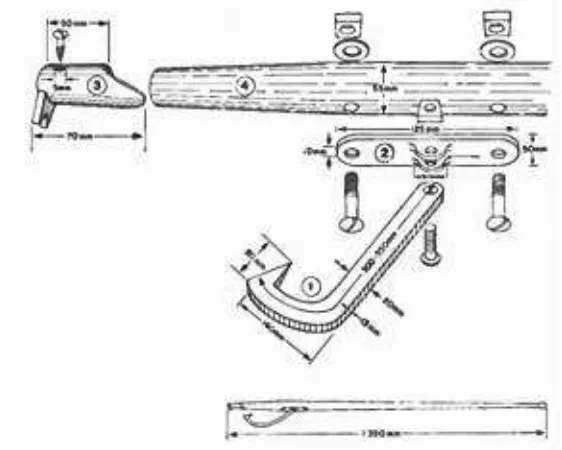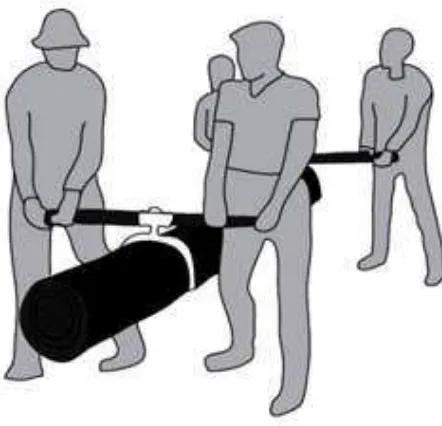2
Hand tools
RECOFTC - The Center for People and Forests
Copyright © RECOFTC December 2015 Bangkok, Thailand
All photos courtesy of RECOFTC except where reference is indicated
Reproduction of this publication for educational or other non-commercial purposes is authorized without prior written permission from the copyright holders provided the source is fully acknowledged. Reproduction of this publication for resale or other commercial purposes is prohibited without written permission of the copyright holder.
This publication has been generously funded by the Ministry for Foreign Afairs of Finland. The views expressed in this publication are those of the authors and do not necessarily relect the views of RECOFTC and our donor organizations.
Table of contents
1. Axes
1
2. Two-man handsaws
1
3. Cant hooks
3
4. Sappie or pickaroon
4
5. Pike and log hook for rafting
5
6. Log jacks
5
7. Log tongs
6
8. Debarking tool
7
Figures
Figure 1. Axe with handle speciications 1
Figure 2. Two-man handsaws with diferent tooth speciications (Siddiqui 1990) 1
Figure 3. Comparison of felling time for chainsaw (Level 1) and two-man handsaw (Level 2) in relation to diameter at breast height (DBH) in Pinus roxburghii (Chir pine)
plantations in Pakistan (Siddiqui 1990) 2
Figure 4. Comparison of delimbing time for chainsaw (Level 1) and one-man hand saw/axe (Level 2)
in relation to DBH in Pinus roxburghii (Chir pine) plantations Pakistan (Siddiqui 1990) 2
Figure 5. Comparison of bucking time for chainsaw (Level 1) and two-man crosscut saw (Level 2)
in relation to DBH in Pinus roxburghii (Chir pine) plantations Pakistan (Siddiqui 1990) 2
Figure 6. Cant hooks 3
Figure 7. Additional kinds of cant hooks 3
Figure 8. Sappie with speciications 4
Figure 9. Application of sappies 4
Figure 10. Pike and log hook for rafting 5
Figure 11. Basic log jack design 5
Figure 12. Log tongs for ground dragging 6
Figure 13. Tongs for og-lifting in a two-man team 6
Figure 14. Tongs for log-lifting in a four-man team. 6
1
1. Axes
If locally made, axe handles should be fabricated from a well-seasoned piece of wood with straight grain. The handle should reach from the cutter's armpit to ingertips and from his hand to the ground (Figure 1-1). If an axe handle is not available as a model, use the dimensions pattern (Figure 1-2). Enlarge and trace the outline of the side of the handle on a piece of wood. Cut away excess wood on the top with a chisel and saw. Trace
the outline of the top of the handle. Cut away excess wood. Finish shaping the handle with a knife. File and sandpaper to the dimensions of the cross sections shown below. The inished handle should be comfortable to hold.
Figure 1. Axe with handle speciications
2. Two-man
handsaws
2
Figure 3. Comparison of felling time for chainsaw (Level 1) and two-man handsaw (Level 2) in relation to diameter at breast height (DBH) in Pinus roxburghii
(Chir pine) plantations in Pakistan (Siddiqui 1990)
Figure 4. Comparison of delimbing time for chainsaw (Level 1) and one-man hand saw/axe (Level 2) in relation to DBH in Pinus roxburghii
(Chir pine) plantations Pakistan (Siddiqui 1990)
3
3. Cant hooks
Cant hooks are used to lift, turn, drag or load small logs. Shapes of the hook and the handhold are shown in Figure 3. The tool can be cut and welded from one piece of iron 280 x 20 x 5 millimeters (mm) (hook). One piece of iron 230 x 20 x 5 mm (handhold), one iron pin 10 mm x 120 mm and a handle from one piece of wood or rubber (handle cover).
Figure 6. Cant hooks
4
4. Sappie or pickaroon
Sappies are used as levers or hooks to, like cant hooks, lift, turn, drag or load logs. They can be made by forging one piece of good quality steel 275-320 x 140 x 60 mm and one wooden handle 1 100-1 300 mm (somewhat longer, but similarly shaped as an axe handle).
Figure 8. Sappie with speciications
Figure 6 shows various applications of the Sappie. It can be used point up as a lever to clear logs caught on obstacles or it can be driven point down into a log to pull it over rough ground. In harvesting on steep terrain, these make ideal tools to keep logs moving (see factsheets on manual downhill skidding and log chutes). They can also be used for loading, unloading or moving logs short distances on level ground.
5
5. Pike and log hook for rafting
This hand tool is used to push, pull or guide loating logs. It can be made from a sheet of lat iron 180 x 180 x 5 mm, a pole 3 000-4 000 mm and four 50 mm screws. The straight spike is for pushing logs. The angled spike is for pulling logs.
Figure 10. Pike and log hook for rafting
6. Log jacks
Log jacks are used to move or turn logs and take down lodged trees. A basic type is presented in Figure 8. They can be made from one iron bar 300-350 x 20 x 13 mm, another iron bar 125 x 50 x 10 mm, one piece of pipe 40 mm inner diameter x 70 mm length, one piece of hardwood 55 mm x 350 mm for the handle, one screw and two bolts 12 mm x 85 mm, and one bolt 12 mm x 40 mm with nuts and washers.
6
Figure 12. Log tongs for ground dragging
7. Log tongs
These tools are used by a single person or team to drag and lift logs. They can be made from two 15 x 25 x 600 mm iron bars, one 15 x 25 x 110 mm iron bar which are heated and bent to form the tong arms, one rivet 10 mm x 70 mm, a length of rope and one round piece of wood 50 mm x 700 mm,. Each arm should have an eye at one end and a point. Two kinds of points are illustrated below.
Figure 13: Tongs for log-lifting in a two-man team
7
8. Debarking tool
Debarking tools are used to strip bark from logs. They can be made from a piece of steel of a used truck spring 130 x 90 x 7 mm, one mild steel rod 15 mm x 1 220 mm, and two pieces of rubber hose or tube with 15-mm inner diameter.
8
References
FAO 1989, “Basic Wood Harvesting Technology,” FAO Training Series 1, Food and Agriculture Organisation (FAO) of the United Nations.
FAO 1982, “Basic technology in forest operations,” FAO Forestry Paper, Food and Agriculture Organisation (FAO) of the United Nations, pp. 132.
Kantola M and Harstela P 1988, “Handbook on Appropriate Technology for Forestry Operations in Developing Countries,” Forestry Training Program, Publication 19.
ILO 1970, “Selection and maintenance of logging hand tools,” International Labour Organization (ILO).
ILO 1989, “Wood Harvesting with Hand Tools - An Illustrated Training Manual,” International Labour Organization (ILO), p. 128.
Laarman, VJ 1981, “Choice of technology in forestry, A Philippine case study,” International Labour Organization (ILO), Quezon City, Philippines, p. 115.
National Board of Vocational Education 1979, “"Planning of logging and log transport in Eastern Africa,” Proceedings of the Seminar on Planning of Logging and Log Transport held from 7 to 25 May 1979 in Kitwe, Zambia, Forestry Training Program for Developing Countries in Helsinki, Finland.
10
RECOFTC’s mission is to enhance capacities for stronger rights, improved governance and fairer beneits for local people in sustainable forested landscapes in the Asia and the Paciic region.
RECOFTC holds a unique and important place in the world of forestry. It is the only international not-for-proit organization that specializes in capacity development for community forestry. RECOFTC engages in strategic networks and efective partnerships with governments, nongovernmental organizations, civil society, the private sector, local people and research and educational institutes throughout the Asia-Paciic region and beyond. With over 25 years of international experience and a dynamic approach to capacity development – involving research and analysis, demonstration sites and training products – RECOFTC delivers innovative solutions for people and forests.
RECOFTC – The Center for People and Forests P.O. Box 1111






